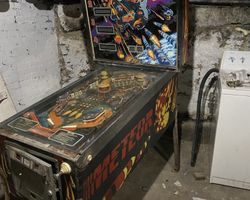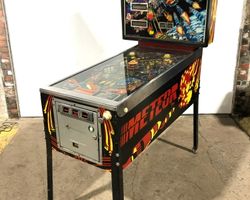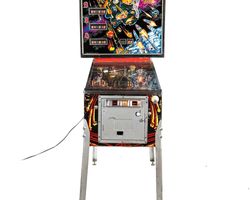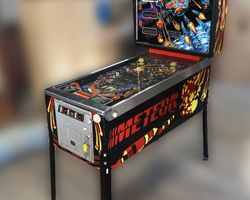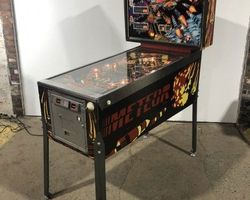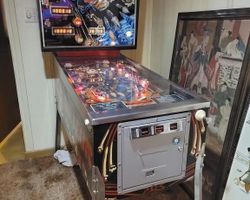Meteor
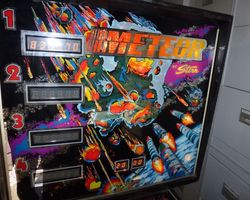
Average Prices: USD $200 to $1,200
Produced: September, 1979
Production Run: 7,939 units
Machine Type: Solid State Electronic
MPU: Stern M-200 MPU
Players: 4
Design by: Steve Kirk
Art by: George Obregon, Jorge Obregon, Leslie Kaip
Software by: Alan McNeil
Stern Electronics, Inc. launched "Meteor" in September 1979, an engaging solid-state pinball machine that captured the zeitgeist of late 1970s science fiction and disaster cinema. The game's theme, centered around an impending cosmic collision, drew direct inspiration from the 1979 movie Meteor, with its backglass and flyer artwork directly derived from an advertising poster for the film, originally painted by space artist Robert McCall. This thematic resonance, combined with the capabilities of early solid-state technology, positioned "Meteor" as a notable release for Stern.
The creation of "Meteor" involved a collaborative design effort. Steve Kirk, a significant figure in pinball design and founder of the Pinball Association of America, was the principal designer. His innovative approach is evident in the machine's layout and unique features. The playfield and cabinet artwork were crafted by Jorge Obregon and Leslie Kaip, who translated the cinematic theme into a visually arresting experience, characterized by vivid colors and a well-executed cosmic backdrop. Alan McNeil was responsible for the software, bringing the mechanical elements to life through digital logic. "Meteor" also marked a significant technical milestone for Stern, as it was the first game to incorporate the SB-300 sound board, laying groundwork for future audio advancements in their machines. The machine saw a substantial production run of 8,362 units, with 7,939 full games and an additional 423 knock-down units produced for licensed manufacturing in Australia by LAI. During its production, a minor yet distinctive detail emerged: a sticker on the lower apron identifying the game as "selected for tournament play." This was Steve Kirk's initiative, reflecting his commitment to organized pinball competition. Another subtle but unique signature of Kirk's design philosophy is found on the backglass itself: the "SK-5" etched onto one of the rockets, indicating "Meteor" as his fifth pinball design. Furthermore, "Meteor" holds the distinction of being the first Stern game to print the rubber ring sizes directly on the playfield, a practical detail that simplified maintenance and parts replacement for operators.
Signature Features and Design
"Meteor" distinguishes itself with a suite of features that contribute to its fast-paced, target-rich gameplay. Central to its design are the extensive banks of drop targets, earning it the affectionate moniker "drop target heaven" among enthusiasts. The playfield features three distinct 3-bank drop target sets, strategically placed to encourage diverse shot angles. A notable inclusion is a single 6-bank memory drop target set, adding a layer of strategic depth as players work to clear them. Complementing these are a spinning target and a standup target, each offering unique scoring opportunities and shot challenges.
The machine incorporates a three-flipper layout, including a crucial third flipper positioned above the main lower flippers, providing access to upper playfield shots that would otherwise be inaccessible. This third flipper not only expands the available shot options but also enhances the flow and potential for combos. For bumpers, "Meteor" features a single pop bumper and two passive bumpers, which contribute to random ball movement and increase scores through rebound action. Three star rollovers are also present, often integral to lighting features or increasing score multipliers. Perhaps the most intriguing and design-defining feature is the mini-post screw situated between the two lower flippers, a unique element known colloquially as the "Kirk Post," named after designer Steve Kirk. This post introduces an element of unpredictability and provides skilled players with the possibility of last-second ball saves or precise nudges that influence ball trajectory, transforming potential drains into scoring opportunities. The artwork, primarily visible on the playfield and backglass, utilizes vivid colors and a cohesive space theme, immersing players in the impending disaster scenario depicted. The overall aesthetic is clean and functional, ensuring that playfield elements are clearly distinguishable while maintaining thematic consistency.
Playfield and Mechanics
The "Meteor" playfield presents an open and inviting layout, designed for sustained ball times and continuous action, which was a hallmark of many solid-state games of its era. At the very bottom, the three-flipper system dominates, with two standard flippers flanking the center drain and the unique Kirk Post. Above these, the third flipper is positioned on the upper right side, providing access to a challenging bank of targets located on the left side of the playfield.
Moving upwards, the playfield is replete with its signature drop targets. On the left side, two 3-bank drop target sets are positioned strategically, one accessible from the lower left flipper and another from the upper right flipper. On the right side, another 3-bank drop target provides a challenging shot from the lower right flipper. The most significant target array is the 6-bank memory drop target set, typically located in the upper-middle or right-hand side of the playfield. These memory targets retain their state between ball drains, encouraging players to work on clearing them over multiple balls for significant bonuses or feature activation.
The playfield also features a prominent spinning target, usually located in the upper-middle section, which can yield high scores when "ripped" repeatedly. A single standup target is often placed near a lane or alongside a target bank, contributing to scoring or mode progression. Three star rollovers are integrated into the lane entrances, which can light extra balls or special awards when completed. The single pop bumper is positioned to create unpredictable bounces and quick scoring, while the two passive bumpers contribute to the chaos and movement of the ball. The artwork on the playfield is clean and thematic, guiding the player's eye towards targets and shot opportunities with clear lines and vibrant colors. The lighting, though simpler than later machines, effectively highlights scoring areas and progression, maintaining player immersion in the sci-fi disaster narrative. The open design philosophy of Steve Kirk for "Meteor" promotes a smooth flow, allowing players to execute rapid shots and maintain control, encouraging a rhythmic gameplay loop focused on precision and target completion.
Gameplay Dynamics
"Meteor" delivers a fast-paced and fundamentally straightforward gameplay experience, characteristic of late 1970s solid-state machines, yet it offers sufficient depth to engage skilled players. The primary objective revolves around clearing the various drop target banks. Each bank, whether a 3-bank or the larger 6-bank memory set, serves as a progressive objective. Clearing a bank typically awards points and can light subsequent features or increase scoring multipliers for other elements on the playfield. The 6-bank memory targets are particularly crucial, as their state persists between balls, allowing players to work towards clearing them over the course of an entire game for a larger bonus or special award.
Beyond the drop targets, the spinning target is a vital component for high scoring. Repeatedly hitting this target can accumulate significant points quickly, often becoming a focal point for players seeking to maximize their score. The three flippers are essential for navigating the open playfield. The upper right flipper is key for accessing the upper left drop targets and other features in that region, adding a strategic dimension to shot selection. The Kirk Post, positioned between the lower flippers, introduces an element of risk and reward; a skilled nudge at the right moment can save a draining ball or redirect it into a scoring lane.
While "Meteor" does not feature complex multi-stage modes common in later machines, its progression is built upon clearing targets to light special awards, extra balls, or score multipliers. For instance, successfully navigating the star rollovers might light an extra ball, while clearing specific drop target banks could enable high-scoring opportunities on other targets. Player strategy often involves prioritizing the memory drop targets to secure their valuable bonus, then focusing on ripping the spinner for immediate points, and finally, systematically clearing the remaining 3-bank targets to maintain continuous play and build score. The game's relatively open playfield layout allows for longer ball times, enabling players to develop a rhythm and execute intricate shot sequences. The scoring system is transparent and directly tied to hitting targets, making it easy for both newcomers to understand and experienced players to strategize around.
Reception and Legacy
Upon its release, and in the decades since, "Meteor" has garnered a largely positive reception within the pinball community, solidifying its place as a classic from Stern Electronics, Inc. Its core strengths lie in its addictive and fun gameplay, which many describe as both fast-paced and accessible. Players consistently praise its engaging nature, citing the "drop target heaven" aspect as a major draw. The abundance of drop targets provides satisfying feedback and clear objectives, making it a compelling experience for both casual players and those seeking to master precise shots. The game is often cited for its excellent value, offering a rich gameplay experience for its era. Its open playfield layout is another frequently highlighted positive, contributing to longer ball times and allowing for a greater sense of control and fluidity during play. The artwork, particularly the backglass inspired by Robert McCall's space art, is generally well-regarded for its thematic coherence and vibrant aesthetic.
However, "Meteor" is not without its polarizing elements, primarily concerning its sound design. While some players find the intense, escalating pitch of the background tones to be exciting and contribute to the game's urgency, a significant portion of the community identifies these sounds as annoying, even maddening over extended play sessions. This specific sound profile often dominates discussions regarding the machine's weaknesses, overshadowing other minor criticisms, which might include a minority finding the game less engaging.
Despite these sonic divisions, "Meteor"'s legacy remains strong. It is widely considered a foundational Stern solid-state game, showcasing the capabilities of the then-new M-200 MPU and the SB-300 sound board. Designer Steve Kirk's influence is evident, from the "Kirk Post" between the flippers—a design choice that added a subtle layer of skill and unpredictability—to the machine being marked "selected for tournament play," reflecting his dedication to competitive pinball. "Meteor" is a game that is easy for beginners to grasp yet offers enough strategic depth with its target banks and high-score potential to captivate more advanced players. Its continued presence in collections and its occasional appearance in media, such as the Buffy the Vampire Slayer episode "Villains," underscore its lasting presence in popular culture. The machine stands as a robust example of late 1970s pinball design, demonstrating how a simple yet effective rule set, combined with engaging features, could create a timeless and enjoyable game.
Sponsored Links
 Ebay Listings
Ebay Listings
 Auction Results
Auction Results
| Cost | Location | Date |
|---|---|---|
| USD $709 |  United States United States |
03 November, 2025 |
| USD $1,300 |  Illinois, United States Illinois, United States |
30 May, 2025 |
| USD $1,800 |  New York, United States New York, United States |
17 April, 2025 |
| USD $500 |  Nevada, United States Nevada, United States |
02 March, 2025 |
| USD $2,100 |  Maryland, United States Maryland, United States |
11 January, 2025 |
| USD $1,600 |  Florida, United States Florida, United States |
06 January, 2025 |
| USD $1,225 |  Florida, United States Florida, United States |
15 October, 2024 |
| USD $3,489 |  Florida, United States Florida, United States |
26 August, 2024 |
| USD $2,850 |  Georgia, United States Georgia, United States |
19 March, 2024 |
| USD $2,100 |  Georgia, United States Georgia, United States |
27 November, 2023 |


Private Policy · Search Website · Contact Us
As an eBay Partner, we may earn a commission from qualifying purchases made through links on this site, at no additional cost to you.
All trademarks and copyrighted materials remain property of their respective owners. All other content copyright 2007 - 2025 Pinpedia.

